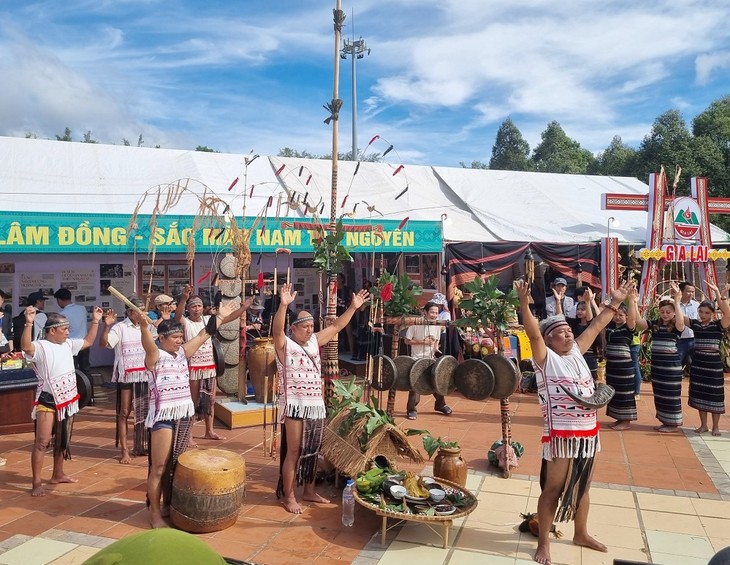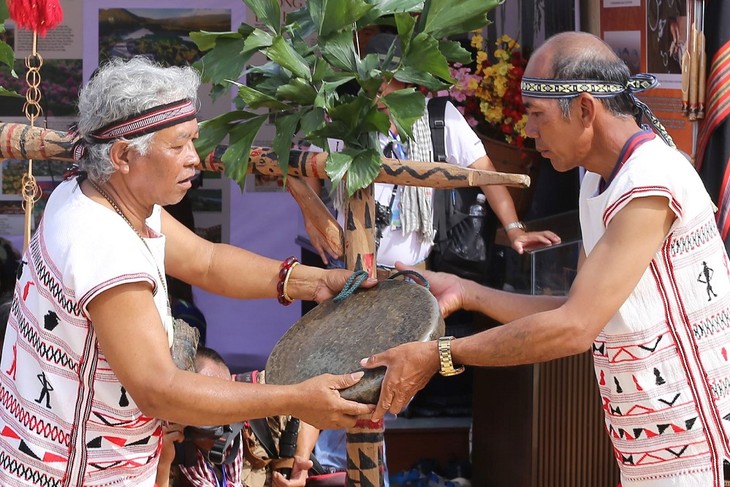(VOVWORLD) - Ethnic groups in the Central Highlands consider the gong a sacred musical instrument which embodies the God spirit. The gongs are associated with community ceremonies. K’Ho people in Lam Dong province dedicate a ritual to pay gratitude to the gong’s God.
 K'Ho men perform a ritual to ask the God of gongs to allow them using the gongs. (Photo: VOV) K'Ho men perform a ritual to ask the God of gongs to allow them using the gongs. (Photo: VOV) |
Not only the K’Ho, but the Mạ, Churu, and M’Nong also believe that every gong is the symbol of a god who grows more powerful as the gong gets older. The gong’s sound is a magical language by which human beings can communicate with God. The God of gongs has the power to protect and make people rich and happy, as well as punish people if they offend against the God.
Before any small or large festival, the Central Highlanders must organize a ritual to invite the God of gongs to attend. For the K’Ho, they hold a ritual to ask for the Heaven God’s permission to use the set of gongs. The worship offerings often include dry fish, salt, rice, steamed sticky rice, chicken, and fruit.
There’s also a ritual of sacrificing an animal to thank the Heaven God. If they have a bumper crop, they hold a big ceremony and offer a buffalo, otherwise the offering can be a goat or chicken.
K’The, a patriarch of Bo Lieng hamlet, Lam Ha district, Lam Dong province, hosted a worship ceremony for a set of six gongs. “Villagers, after a year of hard work, have stockpiled rice in the warehouse and the distilled liquor is ready to drink. We gather here to thank the Heaven God for blessing us with a year of good weather, a bumper rice crop, and big herds of pig and buffalo. Villagers, come to celebrate.”
 The gongs are taken down to play in the festival. (Photo: VOV) The gongs are taken down to play in the festival. (Photo: VOV) |
At a lucky time of the day, K’The blew a buffalo horn and called the villagers to gather around a Neu bamboo tree to begin the ceremony. When everyone arrived, he began the prayer:
“The God of gongs who are residing in big gongs, small gongs, mother gongs, children gongs! We thank you for giving the villagers food to eat and savings. We invite you to attend the festival to celebrate the bumper crop and offer you delicious liquor. Please let us take the gongs down to play resoundingly in the mountains and forests.”
After the village elder prayed and presented the offerings to the God, gongs were taken down from the shelf. Six young men played a melody “Welcoming guest”. After the gong-lowering ceremony, they played a cheerful melody to begin the festival.
Patriarch K'The said: “The village has a set of gongs. The gong-lowering ceremony is to invite the God of gong to join our rituals of sowing seeds, building a house, or wedding. We have to ask for the God’s permission to play the gongs.”
The most interesting part of the gong worship ritual is the gong-playing competition. The men show off their skills by playing gongs so aggressively and loudly that the others cannot play their gongs.
Villager Kra Jan K’Rong said playing gongs and holding festivals are indispensable parts of their lives.“With support of the Party and State, the villagers have striven to preserve the matriarchal customs and intangible heritages.”
Believing that the God is incarnated in gongs, the K’Ho treasure the gongs and play them with care. Villager K’El said gongs are closely associated with important community ceremonies and life cycle rituals.
“The K’Ho play gongs in many occasions, such as the ceremony to bring rice home, weddings, and other important community events. Gongs are precious assets of the K’Ho.”
Life has changed a lot but the K’Ho have preserved their fine tradition and rituals and have passed them down to the next generations.